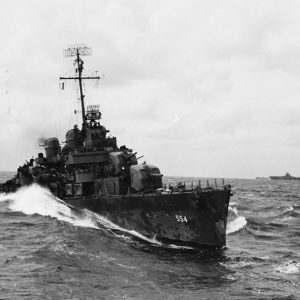calsfoundation@cals.org
USS Franks (DD-554)
The USS Franks (DD-554) was a Fletcher-class U.S. Navy destroyer named for William Joseph Franks, a Civil War sailor who received a Medal of Honor and is buried in Maple Springs (Independence County).
North Carolina–born William Joseph Franks joined the U.S. Navy at DeValls Bluff (Prairie County) on September 15, 1863, and was serving as a seaman aboard the USS Marmora when that vessel sailed to the assistance of Union army troops at Yazoo City, Mississippi, on March 5, 1864. Franks and two other sailors disembarked with a cannon and opened fire on Confederate attackers, defending their gun in hand-to-hand fighting. Franks and the others received the Medal of Honor for their actions. After the war, Franks was a farmer at Maple Springs, where he died on April 18, 1880.
The keel for the USS Franks was laid down on March 8, 1942, in Seattle, Washington, by the Seattle-Tacoma Shipbuilding Corporation. The Franks was launched on December 7, 1942, after being christened by Martha F. W. Carr, who was William Joseph Franks’s cousin. The vessel was commissioned on July 30, 1943, under the command of Lieutenant Commander Nicholas Adair Lidstone.
The USS Franks displaced 2,924 tons when full, was 376 feet six inches long and thirty-nine feet eight inches wide, and could reach speeds of thirty-eight knots with its twin propellers powered by 60,000-horsepower General Electric geared turbines. The destroyer was armed with five five-inch guns, ten 40-millimeter guns, and seven 20-millimeter anti-aircraft guns, as well as depth-charge launchers. The Franks held a crew of 273 sailors and officers.
The USS Franks reached Pearl Harbor on October 25, 1943, and then sailed on November 10 to screen escort carriers during the invasion of Tarawa in the Gilbert Islands. A Japanese submarine slipped through the destroyer screen on November 23 and sank the escort carrier USS Liscome Bay. The Franks patrolled off Betio before returning to Pearl Harbor December 27 for repairs.
The Franks sailed again on January 22, 1944, for the invasion of Kwajalein in the Marshall Islands and conducted close-in reconnaissance and bombardment at Ebeye Island in addition to submarine patrol duties. After replenishing at Pearl Harbor between February 18 and March 4, the vessel conducted patrol and combat duty in the Solomons, including reconnaissance and bombardment missions against Mussau, Kapingamarangi, and Bougainville. While screening mine layers on May 16, the Franks was one of a group of destroyers that sank the Japanese submarine I-176. Commander David Richard Stephan took command of the vessel on June 30 after Lidstone was promoted to rear admiral.
USS Franks participated in the pre-invasion bombardment of Guam beginning on July 12, surviving an attack by a Japanese airplane on July 14, and provided fire support as marines landed on July 21. After taking on supplies at Eniwetok, the Franks sailed for Palau, arriving on September 15; the vessel provided cover for the occupation of Ulithi eight days later. Beginning October 1, the Franks screened escort carriers in the Philippines, covering the invasion of Leyte and fighting in the Battle of Leyte Gulf. In December, the destroyer was part of the fast carrier task force that participated in the invasion of Mindoro and helped to soften up enemy positions for the January 1945 attack on Luzon.
When U.S. forces began invading the Japanese home islands, USS Franks struck Japanese targets on February 16 and 17 prior to the Iwo Jima invasion and, in March, attacked enemy positions in preparation for the Okinawa invasion, downing an enemy aircraft during a March 18 battle. The Franks joined a battleship group for pre-invasion shelling of the island and was badly damaged in a collision with the USS New Jersey on April 2. Commander Stephan was fatally injured in the accident and died on April 4, to be replaced briefly by Lieutenant Gerald F. Case and permanently by Lieutenant Commander Eugene Baker Henry Jr., who would lead the crew for the remainder of the war.
The USS Franks received temporary repairs at Ulithi and then sailed for Puget Sound Navy Yard for a complete overhaul. The destroyer headed back to the western Pacific on August 10, 1945, with the crew learning of Japan’s August 15 capitulation while en route. The Franks entered Tokyo Bay on September 13. On October 1, the ship set sail for the United States, having earned nine battle stars during World War II. The USS Franks was decommissioned at San Pedro, California, on May 31, 1946; struck from the Navy List on December 1, 1972; and sold for scrap on August 1, 1973.
For additional information:
“Franks (DD-554).” Naval History and Heritage Command. https://www.history.navy.mil/research/histories/ship-histories/danfs/f/franks.html (accessed December 21, 2020).
“USS Franks (DD-554).” National Association of Destroyer Veterans. http://www.destroyers.org/histories/h-dd-554.htm (accessed December 21, 2020).
“USS Franks (DD-554).” NavSource.org. http://www.navsource.org/archives/05/554.htm (accessed December 21, 2020).
Mark K. Christ
Central Arkansas Library System
 Military
Military USS Franks
USS Franks 




Comments
No comments on this entry yet.